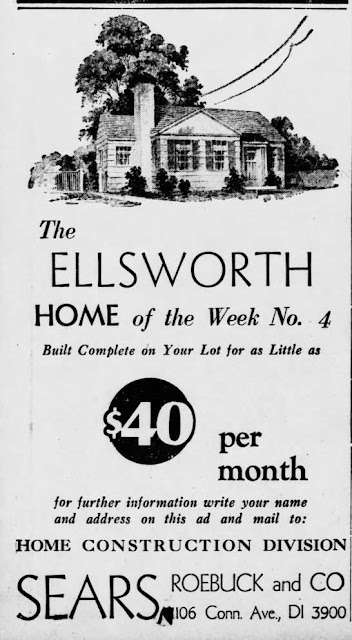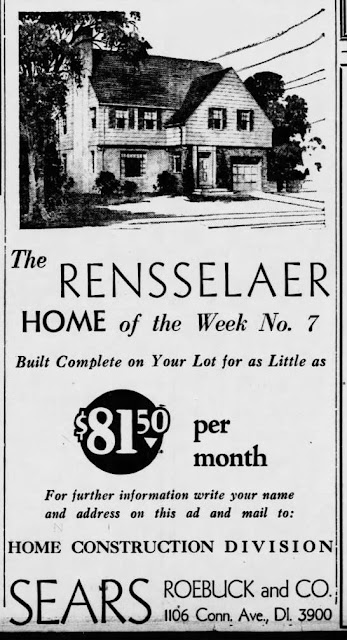Over at Sears Homes of Chicagoland, Lara's latest post is exploring examples of advertising for "Modern Homes" from Sears Roebuck. Advertising for the "Modern Homes" program appeared in a number of different formats but the ones I've most frequently come across were ads in newspapers from those parts of the county where Sears sold their "Modern Homes". Thanks to digitization efforts, we've been able to see numerous examples of ads from a number of newspapers. Lara's post reminded me of some advertising I had come across again a few weeks ago while searching old newspapers for articles. These ads from Sears "Home Construction Division" featured a number of "Modern Homes" models. I'm calling these ads the Sears "Home of the Week" series. Let's take a look!
It was late 1932 and Sears Roebuck's "Modern Homes" program was in trouble. The United States was into the third year of an economic downturn that we now know as the "Great Depression". Even though the economic downturn had started in the late summer of 1929, followed by the stock market crash that started on "Black Thursday" in October 1929, the "Modern Homes" program had managed to chug along with sales of $12 million in 1930 and $12.7 million in 1931. Fueling these sales were generous lending policies with Sears willing to finance up to 75% of the cost of a new home, including labor and extras, for up to 15 years, terms that had been unheard of just a few years prior. Sears heralded these lending policies as the future of home financing (a pronouncement that turned out to be accurate).
But by 1932, the reality of the Great Depression was weighing on the "Modern Homes" program. Sales were down significantly even as Sears salesmen relied on even more aggressive forms of financing, including large number of homes financed with two mortgages (the final 1932 sales numbers were $7.5 million). At the same time Sears was dealing with declining home sales, the company was experiencing ever increasing number of customers defaulting on previously issued loans. People without jobs - the national unemployment rate would top out at an astounding 25% in early 1933 - couldn't afford to put food on the table, much less pay for the roof over their head.Despite all these economic headwinds, in the fall of 1932, the Sears "Modern Homes" offices in Washington DC and Baltimore, Maryland ran a series of weekly ads in the "Evening Star" (Washington DC) and the "Baltimore Sun" and "Evening Sun" (Baltimore, Maryland) promoting the opportunity to construct a new home through the "Home Construction Division" of Sears. Appropriately named "Home of the Week", these ads featured a different model each week. Some of the homes featured could be found in the 1932 "Modern Homes" catalog while others would make their debut in the forthcoming 1933 catalog. For approximately 3 months, Sears featured a different model each week (with a couple of repeats). The sales pitch to prospective customers was the opportunity to purchase a new home from Sears that would be built by the "Home Construction Division". No need to DIY that new home purchase, Sears would assemble it for you.
 |
| Portion of an ad in the "Evening Star" |
Sears realized that by this point, the only people who were in the market for building a new home were those who were secure in their employment and/or finances. In Washington DC, people employed by a federal government expanding to meet the national crisis of the Depression, provided a potential pool of customers that likely didn't exist in many places elsewhere in the country (although even there, we don't see large number of mortgages issued for homes in Washington DC or the surrounding counties in Maryland in 1933).
Of interest to kit house researchers is that several models featured in the ads appeared in the 1933 catalog under a different name. In the case of the "Wexford", it was renamed to the "Bridgeport". This was the case with a number of models that appeared in the 1932 catalog. But in the case of the "Dominion", "Fairfax" and "Rensselaer", those models had not yet even made an appearance in the "Modern Homes" catalog. When the 1933 catalog was published, they had been renamed to the "Belfast", "Alden" and "Schuyler". Lara wrote about the "Rensselaer/Schuyler" and how only one example of the house may have been built. We also get to see a preview of the "Homestead", one of several split-level design houses that first appeared in the 1933 catalog.
Despite Sears efforts to boost sales, 1933 sales were just $3.5 million and the massive number of defaulted mortgages (over 1,000 homes repossessed at one point) drove Sears out of the financing business. Some of the houses featured below would continue to appear for a number of years while others made their final appearance in the 1933 catalog, never to be seen again.
OK, enough of the history lesson, let's see the houses! I've presented the houses in the order that they appeared in the newspapers (9 houses/11 ads in the "Evening Star", 13 in the "Baltimore Sun/Evening Sun"). There were a couple of repeats so I didn't include the extra ad that appeared in the Baltimore papers.
1. Sears "Homestead"
2. Sears "Wexford"
3. Sears "Richmond"
4. Sears "Ellsworth"
5. Sears "Dominion"
6. Sears "Fairfax"
7. Sears "Rensselaer"
8. Sears "Homestead"
9. Sears "Brookwood"
10. Sears "Ellsworth"
11. Sears "Jeanette"














Those Home of the Week ads are really cute. I think some of the local offices ran better ads than Sears did nationally.
ReplyDeleteAgreed!
Delete